Vasu Sharma
Reasoning Relay: Evaluating Stability and Interchangeability of Large Language Models in Mathematical Reasoning
Dec 16, 2025Abstract:Chain-of-Thought (CoT) prompting has significantly advanced the reasoning capabilities of large language models (LLMs). While prior work focuses on improving model performance through internal reasoning strategies, little is known about the interchangeability of reasoning across different models. In this work, we explore whether a partially completed reasoning chain from one model can be reliably continued by another model, either within the same model family or across families. We achieve this by assessing the sufficiency of intermediate reasoning traces as transferable scaffolds for logical coherence and final answer accuracy. We interpret this interchangeability as a means of examining inference-time trustworthiness, probing whether reasoning remains both coherent and reliable under model substitution. Using token-level log-probability thresholds to truncate reasoning at early, mid, and late stages from our baseline models, Gemma-3-4B-IT and LLaMA-3.1-70B-Instruct, we conduct continuation experiments with Gemma-3-1B-IT and LLaMA-3.1-8B-Instruct to test intra-family and cross-family behaviors. Our evaluation pipeline leverages truncation thresholds with a Process Reward Model (PRM), providing a reproducible framework for assessing reasoning stability via model interchange. Evaluations with a PRM reveal that hybrid reasoning chains often preserve, and in some cases even improve, final accuracy and logical structure. Our findings point towards interchangeability as an emerging behavioral property of reasoning models, offering insights into new paradigms for reliable modular reasoning in collaborative AI systems.
WOLF: Werewolf-based Observations for LLM Deception and Falsehoods
Dec 09, 2025Abstract:Deception is a fundamental challenge for multi-agent reasoning: effective systems must strategically conceal information while detecting misleading behavior in others. Yet most evaluations reduce deception to static classification, ignoring the interactive, adversarial, and longitudinal nature of real deceptive dynamics. Large language models (LLMs) can deceive convincingly but remain weak at detecting deception in peers. We present WOLF, a multi-agent social deduction benchmark based on Werewolf that enables separable measurement of deception production and detection. WOLF embeds role-grounded agents (Villager, Werewolf, Seer, Doctor) in a programmable LangGraph state machine with strict night-day cycles, debate turns, and majority voting. Every statement is a distinct analysis unit, with self-assessed honesty from speakers and peer-rated deceptiveness from others. Deception is categorized via a standardized taxonomy (omission, distortion, fabrication, misdirection), while suspicion scores are longitudinally smoothed to capture both immediate judgments and evolving trust dynamics. Structured logs preserve prompts, outputs, and state transitions for full reproducibility. Across 7,320 statements and 100 runs, Werewolves produce deceptive statements in 31% of turns, while peer detection achieves 71-73% precision with ~52% overall accuracy. Precision is higher for identifying Werewolves, though false positives occur against Villagers. Suspicion toward Werewolves rises from ~52% to over 60% across rounds, while suspicion toward Villagers and the Doctor stabilizes near 44-46%. This divergence shows that extended interaction improves recall against liars without compounding errors against truthful roles. WOLF moves deception evaluation beyond static datasets, offering a dynamic, controlled testbed for measuring deceptive and detective capacity in adversarial multi-agent interaction.
SALT: Steering Activations towards Leakage-free Thinking in Chain of Thought
Nov 11, 2025Abstract:As Large Language Models (LLMs) evolve into personal assistants with access to sensitive user data, they face a critical privacy challenge: while prior work has addressed output-level privacy, recent findings reveal that LLMs often leak private information through their internal reasoning processes, violating contextual privacy expectations. These leaky thoughts occur when models inadvertently expose sensitive details in their reasoning traces, even when final outputs appear safe. The challenge lies in preventing such leakage without compromising the model's reasoning capabilities, requiring a delicate balance between privacy and utility. We introduce Steering Activations towards Leakage-free Thinking (SALT), a lightweight test-time intervention that mitigates privacy leakage in model's Chain of Thought (CoT) by injecting targeted steering vectors into hidden state. We identify the high-leakage layers responsible for this behavior. Through experiments across multiple LLMs, we demonstrate that SALT achieves reductions including $18.2\%$ reduction in CPL on QwQ-32B, $17.9\%$ reduction in CPL on Llama-3.1-8B, and $31.2\%$ reduction in CPL on Deepseek in contextual privacy leakage dataset AirGapAgent-R while maintaining comparable task performance and utility. Our work establishes SALT as a practical approach for test-time privacy protection in reasoning-capable language models, offering a path toward safer deployment of LLM-based personal agents.
A Comprehensive Dataset for Human vs. AI Generated Text Detection
Oct 26, 2025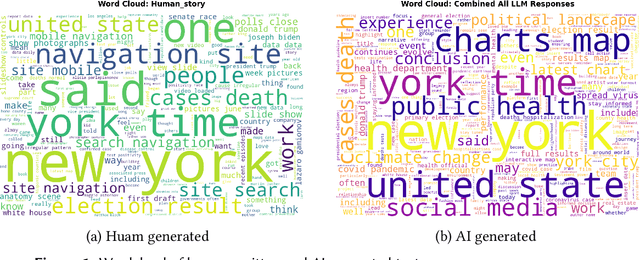
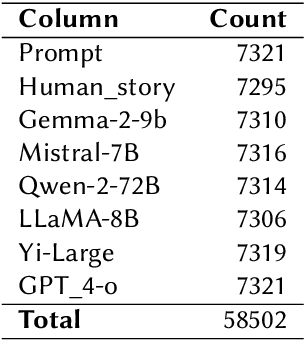


Abstract:The rapid advancement of large language models (LLMs) has led to increasingly human-like AI-generated text, raising concerns about content authenticity, misinformation, and trustworthiness. Addressing the challenge of reliably detecting AI-generated text and attributing it to specific models requires large-scale, diverse, and well-annotated datasets. In this work, we present a comprehensive dataset comprising over 58,000 text samples that combine authentic New York Times articles with synthetic versions generated by multiple state-of-the-art LLMs including Gemma-2-9b, Mistral-7B, Qwen-2-72B, LLaMA-8B, Yi-Large, and GPT-4-o. The dataset provides original article abstracts as prompts, full human-authored narratives. We establish baseline results for two key tasks: distinguishing human-written from AI-generated text, achieving an accuracy of 58.35\%, and attributing AI texts to their generating models with an accuracy of 8.92\%. By bridging real-world journalistic content with modern generative models, the dataset aims to catalyze the development of robust detection and attribution methods, fostering trust and transparency in the era of generative AI. Our dataset is available at: https://huggingface.co/datasets/gsingh1-py/train.
ERGO: Entropy-guided Resetting for Generation Optimization in Multi-turn Language Models
Oct 15, 2025Abstract:Large Language Models (LLMs) suffer significant performance degradation in multi-turn conversations when information is presented incrementally. Given that multi-turn conversations characterize everyday interactions with LLMs, this degradation poses a severe challenge to real world usability. We hypothesize that abrupt increases in model uncertainty signal misalignment in multi-turn LLM interactions, and we exploit this insight to dynamically realign conversational context. We introduce ERGO (Entropy-guided Resetting for Generation Optimization), which continuously quantifies internal uncertainty via Shannon entropy over next token distributions and triggers adaptive prompt consolidation when a sharp spike in entropy is detected. By treating uncertainty as a first class signal rather than a nuisance to eliminate, ERGO embraces variability in language and modeling, representing and responding to uncertainty. In multi-turn tasks with incrementally revealed instructions, ERGO yields a 56.6% average performance gain over standard baselines, increases aptitude (peak performance capability) by 24.7%, and decreases unreliability (variability in performance) by 35.3%, demonstrating that uncertainty aware interventions can improve both accuracy and reliability in conversational AI.
Filtering for Creativity: Adaptive Prompting for Multilingual Riddle Generation in LLMs
Aug 26, 2025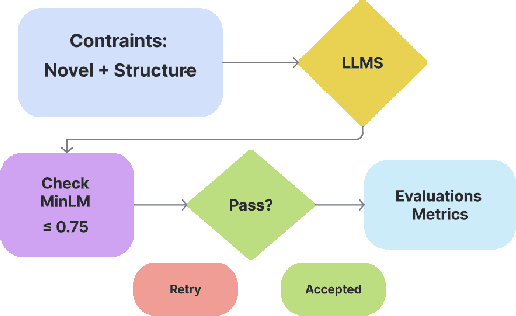
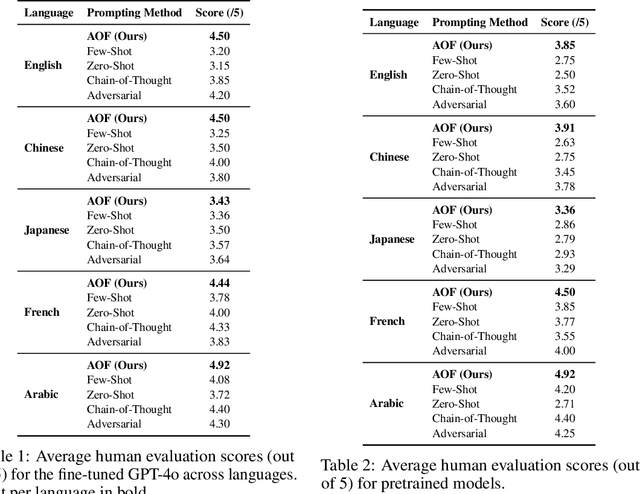
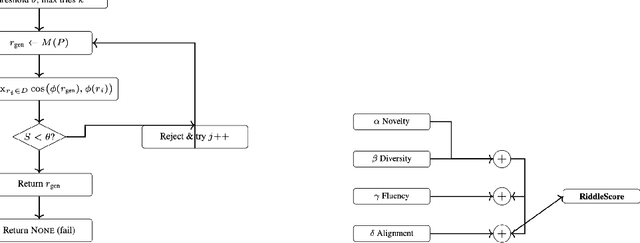
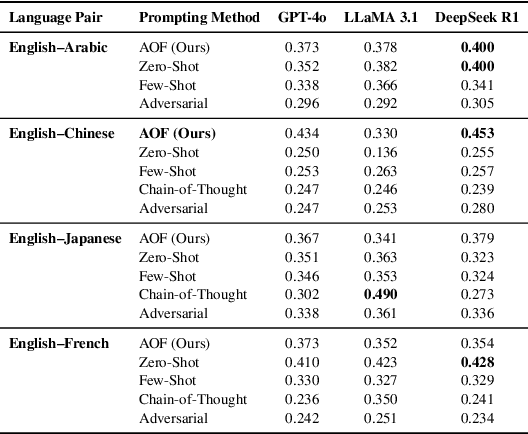
Abstract:Multilingual riddle generation challenges large language models (LLMs) to balance cultural fluency with creative abstraction. Standard prompting strategies -- zero-shot, few-shot, chain-of-thought -- tend to reuse memorized riddles or perform shallow paraphrasing. We introduce Adaptive Originality Filtering (AOF), a prompting framework that filters redundant generations using cosine-based similarity rejection, while enforcing lexical novelty and cross-lingual fidelity. Evaluated across three LLMs and four language pairs, AOF-enhanced GPT-4o achieves \texttt{0.177} Self-BLEU and \texttt{0.915} Distinct-2 in Japanese, signaling improved lexical diversity and reduced redundancy compared to other prompting methods and language pairs. Our findings show that semantic rejection can guide culturally grounded, creative generation without task-specific fine-tuning.
Understanding Trade offs When Conditioning Synthetic Data
Jul 03, 2025Abstract:Learning robust object detectors from only a handful of images is a critical challenge in industrial vision systems, where collecting high quality training data can take months. Synthetic data has emerged as a key solution for data efficient visual inspection and pick and place robotics. Current pipelines rely on 3D engines such as Blender or Unreal, which offer fine control but still require weeks to render a small dataset, and the resulting images often suffer from a large gap between simulation and reality. Diffusion models promise a step change because they can generate high quality images in minutes, yet precise control, especially in low data regimes, remains difficult. Although many adapters now extend diffusion beyond plain text prompts, the effect of different conditioning schemes on synthetic data quality is poorly understood. We study eighty diverse visual concepts drawn from four standard object detection benchmarks and compare two conditioning strategies: prompt based and layout based. When the set of conditioning cues is narrow, prompt conditioning yields higher quality synthetic data; as diversity grows, layout conditioning becomes superior. When layout cues match the full training distribution, synthetic data raises mean average precision by an average of thirty four percent and by as much as one hundred seventy seven percent compared with using real data alone.
AdversariaL attacK sAfety aLIgnment(ALKALI): Safeguarding LLMs through GRACE: Geometric Representation-Aware Contrastive Enhancement- Introducing Adversarial Vulnerability Quality Index (AVQI)
Jun 11, 2025
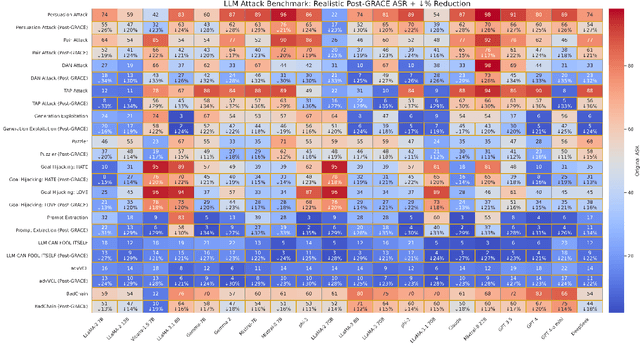
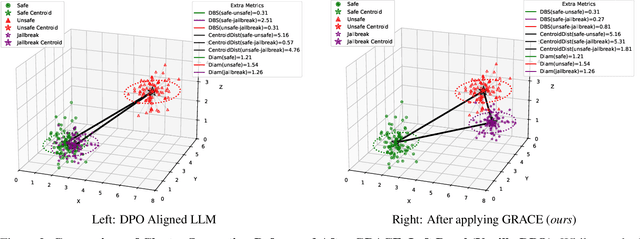

Abstract:Adversarial threats against LLMs are escalating faster than current defenses can adapt. We expose a critical geometric blind spot in alignment: adversarial prompts exploit latent camouflage, embedding perilously close to the safe representation manifold while encoding unsafe intent thereby evading surface level defenses like Direct Preference Optimization (DPO), which remain blind to the latent geometry. We introduce ALKALI, the first rigorously curated adversarial benchmark and the most comprehensive to date spanning 9,000 prompts across three macro categories, six subtypes, and fifteen attack families. Evaluation of 21 leading LLMs reveals alarmingly high Attack Success Rates (ASRs) across both open and closed source models, exposing an underlying vulnerability we term latent camouflage, a structural blind spot where adversarial completions mimic the latent geometry of safe ones. To mitigate this vulnerability, we introduce GRACE - Geometric Representation Aware Contrastive Enhancement, an alignment framework coupling preference learning with latent space regularization. GRACE enforces two constraints: latent separation between safe and adversarial completions, and adversarial cohesion among unsafe and jailbreak behaviors. These operate over layerwise pooled embeddings guided by a learned attention profile, reshaping internal geometry without modifying the base model, and achieve up to 39% ASR reduction. Moreover, we introduce AVQI, a geometry aware metric that quantifies latent alignment failure via cluster separation and compactness. AVQI reveals when unsafe completions mimic the geometry of safe ones, offering a principled lens into how models internally encode safety. We make the code publicly available at https://anonymous.4open.science/r/alkali-B416/README.md.
Distill CLIP (DCLIP): Enhancing Image-Text Retrieval via Cross-Modal Transformer Distillation
Jun 01, 2025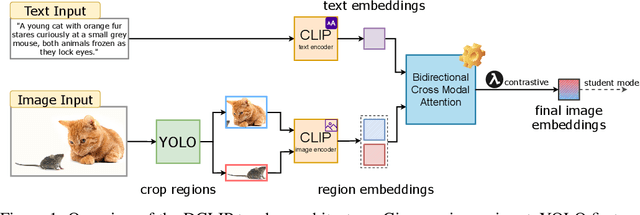


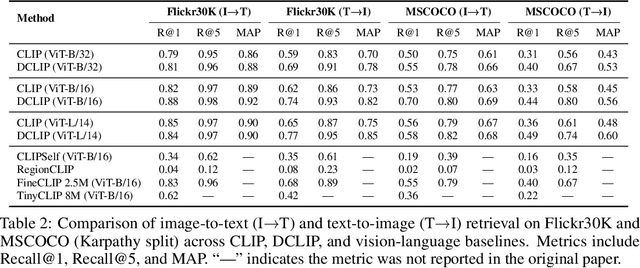
Abstract:We present Distill CLIP (DCLIP), a fine-tuned variant of the CLIP model that enhances multimodal image-text retrieval while preserving the original model's strong zero-shot classification capabilities. CLIP models are typically constrained by fixed image resolutions and limited context, which can hinder their effectiveness in retrieval tasks that require fine-grained cross-modal understanding. DCLIP addresses these challenges through a meta teacher-student distillation framework, where a cross-modal transformer teacher is fine-tuned to produce enriched embeddings via bidirectional cross-attention between YOLO-extracted image regions and corresponding textual spans. These semantically and spatially aligned global representations guide the training of a lightweight student model using a hybrid loss that combines contrastive learning and cosine similarity objectives. Despite being trained on only ~67,500 samples curated from MSCOCO, Flickr30k, and Conceptual Captions-just a fraction of CLIP's original dataset-DCLIP significantly improves image-text retrieval metrics (Recall@K, MAP), while retaining approximately 94% of CLIP's zero-shot classification performance. These results demonstrate that DCLIP effectively mitigates the trade-off between task specialization and generalization, offering a resource-efficient, domain-adaptive, and detail-sensitive solution for advanced vision-language tasks. Code available at https://anonymous.4open.science/r/DCLIP-B772/README.md.
From Directions to Cones: Exploring Multidimensional Representations of Propositional Facts in LLMs
May 27, 2025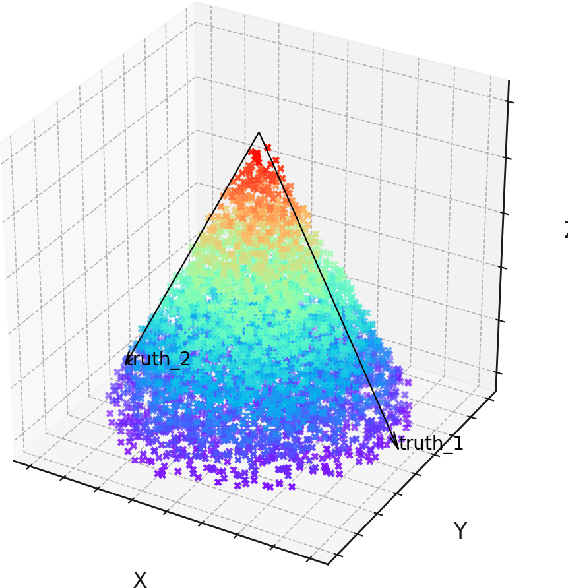
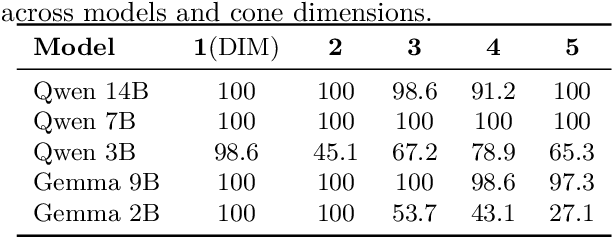
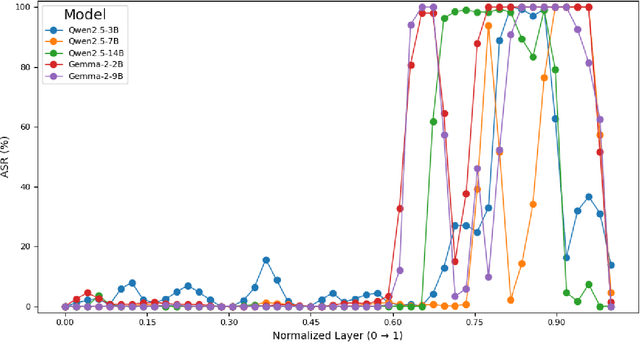
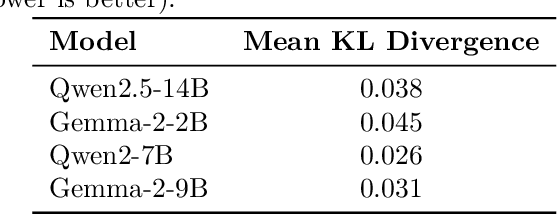
Abstract:Large Language Models (LLMs) exhibit strong conversational abilities but often generate falsehoods. Prior work suggests that the truthfulness of simple propositions can be represented as a single linear direction in a model's internal activations, but this may not fully capture its underlying geometry. In this work, we extend the concept cone framework, recently introduced for modeling refusal, to the domain of truth. We identify multi-dimensional cones that causally mediate truth-related behavior across multiple LLM families. Our results are supported by three lines of evidence: (i) causal interventions reliably flip model responses to factual statements, (ii) learned cones generalize across model architectures, and (iii) cone-based interventions preserve unrelated model behavior. These findings reveal the richer, multidirectional structure governing simple true/false propositions in LLMs and highlight concept cones as a promising tool for probing abstract behaviors.
 Add to Chrome
Add to Chrome Add to Firefox
Add to Firefox Add to Edge
Add to Edge